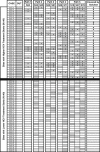Strategy Configurations Directly Linked to Higher Hepatitis C Virus Treatment Starts: An Applied Use of Configurational Comparative Methods
- PMID: 32187105
- PMCID: PMC7161717
- DOI: 10.1097/MLR.0000000000001319
Strategy Configurations Directly Linked to Higher Hepatitis C Virus Treatment Starts: An Applied Use of Configurational Comparative Methods
Abstract
Background: The Department of Veterans Affairs (VA) cares for more patients with hepatitis C virus (HCV) than any other US health care system. We tracked the implementation strategies that VA sites used to implement highly effective new treatments for HCV with the aim of uncovering how combinations of implementation strategies influenced the uptake of the HCV treatment innovation. We applied Configurational Comparative Methods (CCMs) to uncover causal dependencies and identify difference-making strategy configurations, and to distinguish higher from lower HCV treating sites.
Methods: We surveyed providers to assess VA sites' use of 73 implementation strategies to promote HCV treatment in the fiscal year 2015. CCMs were used to identify strategy configurations that uniquely distinguished higher HCV from lower HCV treating sites.
Results: From the 73 possible implementation strategies, CCMs identified 5 distinct strategy configurations, or "solution paths." These were comprised of 10 individual strategies that collectively explained 80% of the sites with higher HCV treatment starts with 100% consistency. Using any one of the following 5 solution paths was sufficient to produce higher treatment starts: (1) technical assistance; (2) engaging in a learning collaborative AND designating leaders; (3) site visits AND outreach to patients to promote uptake and adherence; (4) developing resource sharing agreements AND an implementation blueprint; OR (5) creating new clinical teams AND sharing quality improvement knowledge with other sites AND engaging patients. There was equifinality in that the presence of any one of the 5 solution paths was sufficient for higher treatment starts.
Conclusions: Five strategy configurations distinguished higher HCV from lower HCV treating sites with 100% consistency. CCMs represent a methodological advancement that can help inform high-yield implementation strategy selection and increase the efficiency and effectiveness of future implementation efforts.
Conflict of interest statement
The authors declare no conflict of interest.
Figures

Similar articles
-
Longitudinal assessment of the association between implementation strategy use and the uptake of hepatitis C treatment: Year 2.Implement Sci. 2019 Apr 8;14(1):36. doi: 10.1186/s13012-019-0881-7. Implement Sci. 2019. PMID: 30961615 Free PMC article.
-
The association between implementation strategy use and the uptake of hepatitis C treatment in a national sample.Implement Sci. 2017 May 11;12(1):60. doi: 10.1186/s13012-017-0588-6. Implement Sci. 2017. PMID: 28494811 Free PMC article.
-
Curing Hepatitis C Virus Infection: Best Practices From the U.S. Department of Veterans Affairs.Ann Intern Med. 2017 Oct 3;167(7):499-504. doi: 10.7326/M17-1073. Epub 2017 Sep 26. Ann Intern Med. 2017. PMID: 28973196
-
Hepatitis C Care in the Department of Veterans Affairs: Building a Foundation for Success.Infect Dis Clin North Am. 2018 Jun;32(2):281-292. doi: 10.1016/j.idc.2018.02.011. Infect Dis Clin North Am. 2018. PMID: 29778256 Review.
-
Evidence Brief: Comparative Effectiveness of Appointment Recall Reminder Procedures for Follow-up Appointments [Internet].Washington (DC): Department of Veterans Affairs (US); 2015 Jul. Washington (DC): Department of Veterans Affairs (US); 2015 Jul. PMID: 27606388 Free Books & Documents. Review.
Cited by
-
Difference-Making Pathways to Frailty Through Social Factors: A Configurational Analysis.Gerontologist. 2024 Jun 1;64(6):gnad173. doi: 10.1093/geront/gnad173. Gerontologist. 2024. PMID: 38150359 Free PMC article.
-
A cluster randomized stepped-wedge trial to de-implement unnecessary post-operative antibiotics in children: the optimizing perioperative antibiotic in children (OPerAtiC) trial.Implement Sci. 2021 Mar 19;16(1):29. doi: 10.1186/s13012-021-01096-1. Implement Sci. 2021. PMID: 33741048 Free PMC article. Clinical Trial.
-
Coming back for more: factors linked to higher participation among Veterans with chronic pain in an innovative VA-YMCA wellness clinic.BMJ Open Qual. 2024 Jan 29;13(1):e002523. doi: 10.1136/bmjoq-2023-002523. BMJ Open Qual. 2024. PMID: 38286565 Free PMC article.
-
Evaluation of organizational capacity in the implementation of a church-based cancer education program.Glob Implement Res Appl. 2022 Mar;2(1):22-33. doi: 10.1007/s43477-021-00033-0. Epub 2022 Jan 7. Glob Implement Res Appl. 2022. PMID: 35392361 Free PMC article.
-
Coincidence analysis: a new method for causal inference in implementation science.Implement Sci. 2020 Dec 11;15(1):108. doi: 10.1186/s13012-020-01070-3. Implement Sci. 2020. PMID: 33308250 Free PMC article.
References
-
- Belperio PS, Chartier M, Gonzalez RI, et al. Hepatitis C care in the Department of Veterans Affairs: building a foundation for success. Infect Dis Clin North Am. 2018;32:281–292. - PubMed
-
- Backus LI, Belperio PS, Shahoumian TA, et al. Real‐world effectiveness of ledipasvir/sofosbuvir in 4365 treatment‐naive, genotype 1 hepatitis C‐infected patients. Hepatology. 2016;64:405–414. - PubMed
-
- Belperio PS, Chartier M, Ross DB, et al. Curing hepatitis C virus infection: best practices from the US Department of Veterans Affairs. Ann Intern Med. 2017;167:499–504. - PubMed
-
- Hagg HW, Workman-Germann J, Flanagan M, et al. Henriksen K, Battles JB, Keyes MA. Implementation of systems redesign: approaches to spread and sustain adoption. Advances in Patient Safety: New Directions and Alternative Approaches (Vol 2: Culture and Redesign). Rockville, MD: Agency for Healthcare Research and Quality (US); 2008. Available at: https://www.ncbi.nlm.nih.gov/books/NBK43727/. - PubMed

